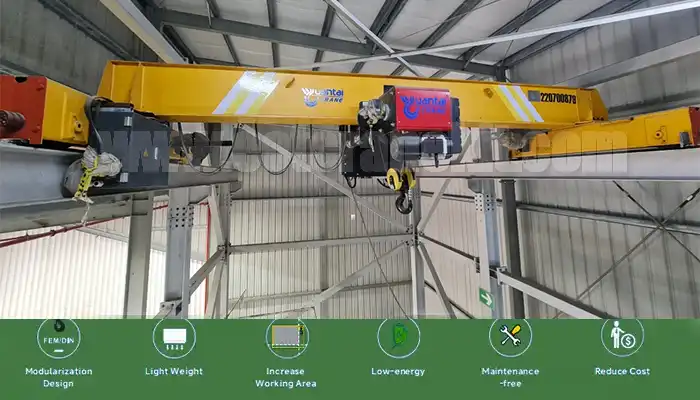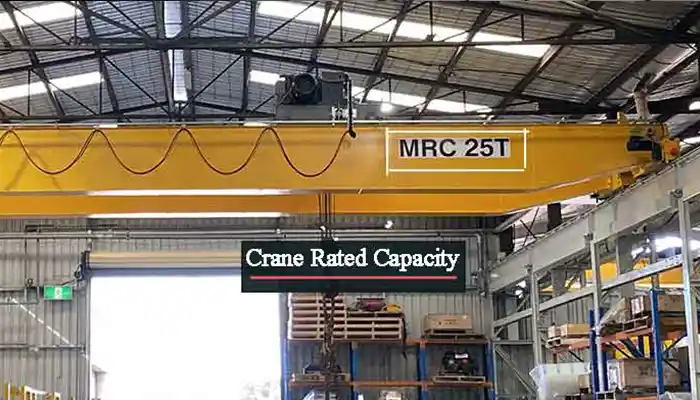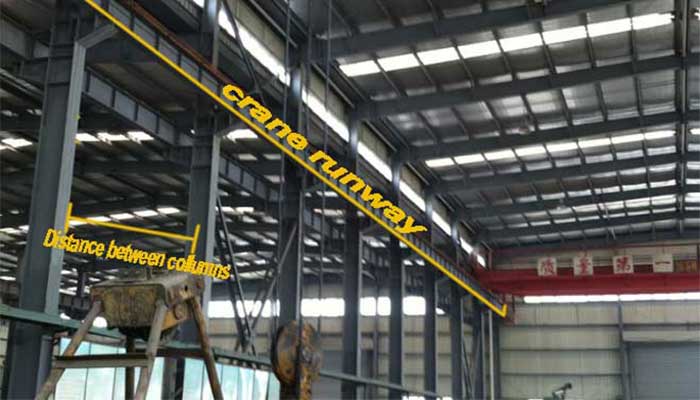
Calculate Workshop Crane Capacity & Reach for Maintenance
Accurately calculating the capacity and reach of a workshop overhead crane is more than just numbers on paper—it directly affects safety, efficiency, and the smooth running of maintenance operations. Lifting too heavy a load or reaching too far without proper planning can lead to accidents, equipment damage, or costly downtime. On the other hand, a well-planned crane layout ensures that materials and tools are always within reach, and work flows without interruptions.
When planning crane operations, there are a few key factors to keep in mind. These include the weight of the loads, the length of the bridge, the span of the trolley, and the overall reach required to cover your workspace. But it's not just about what you need today. You also have to think about the future—whether you might need to lift heavier equipment or expand your maintenance area. Proper planning now saves headaches and extra costs later.
Key considerations for crane planning:
- Safety first: Always include a margin above the heaviest expected load to prevent overloading.
- Efficiency in operation: Ensure the crane can cover the entire maintenance area without leaving blind spots.
- Future-proofing: Consider potential growth in equipment size or changes in workflow to avoid redesigns later.
- Practical layout: Evaluate trolley span and bridge length to minimize travel time and maximize coverage.
Determining Load Weight
One of the first steps in planning a workshop overhead crane is understanding exactly what you'll be lifting. Getting this wrong can lead to serious safety issues, costly equipment damage, or unexpected downtime. The goal is simple: know your loads inside and out so the crane can handle them safely and efficiently.

What Is Overhead Crane Capacity & Working Load Limit?
Assessing Current Loads
Start by identifying the heaviest pieces of equipment, tools, or materials the crane will need to lift. Don't just rely on estimates—measure or confirm actual weights whenever possible. Keep in mind that the way a load is shaped or arranged can change how it behaves when lifted.
- Determine the maximum single load your crane will encounter.
- Consider weight distribution—is it balanced or uneven? Uneven loads can place extra stress on the hoist and bridge.
- Account for load dynamics, including starts, stops, and any swinging that might occur during lifting or movement.
Accounting for Load Variability
Not all lifts are uniform. Some materials come in bundles, irregular shapes, or varying weights. Planning for these variations is essential to prevent overload situations. It's better to be conservative and include a safety margin when defining your crane's capacity.
- Factor in uneven, bundled, or irregular loads that may affect stability.
- Add a safety margin of 10–25% above the maximum expected load. This ensures the crane can handle unexpected variations without risk.
- Reassess periodically if your workshop handles new types of equipment or materials over time.
By carefully evaluating both your current loads and potential variations, you create a solid foundation for selecting the right crane. It's not just about lifting weight—it's about lifting safely, efficiently, and reliably.
Trolley Travelling Crane Span Considerations
The trolley span of an overhead maintanenance crane is one of those details that can make a big difference in daily maintenance operations. It's not just a number—it affects how easily the crane can move loads, how stable it is, and what kind of equipment is required to support it. Understanding trolley span helps you plan for efficiency, safety, and future growth.
Defining Trolley Span
Simply put, the trolley span is the distance between the wheels of the trolley across the bridge girder. This measurement determines how far the hoist can reach across the crane's bridge, directly affecting where you can position and move loads.
- Measure the distance between trolley wheels to define span accurately.
- Consider how span affects load positioning flexibility—a wider span can cover more area, but may require stronger structural support.
- Factor in the layout of your workshop to ensure the crane can reach all critical workstations without leaving blind spots.
Impact on Crane Performance
The trolley span doesn't just affect reach; it also impacts the overall performance and durability of the crane. Longer spans increase stress on the bridge and trolley motors, so they must be properly designed to handle these loads. Stability and safety are closely linked to span, especially when lifting heavy or uneven loads.
- Longer spans may require stronger girders or higher-capacity motors to handle the extra load safely.
- Consider bridge deflection—longer spans can bend slightly under heavy loads, affecting precision and safety.
- Ensure that stability and performance are balanced with operational needs, avoiding over-engineering but also preventing potential risks.
A well-planned trolley span makes everyday lifting tasks smoother, safer, and more efficient. It's a small detail with a big impact, so take the time to measure, plan, and test before finalizing your crane setup.
Bridge Length Calculations
The bridge length of your overhead crane defines how far it can travel across your workshop. Getting this right is crucial. Too short, and you'll leave areas unreachable; too long, and you risk wasting resources or creating safety issues. Careful planning ensures the crane covers all necessary zones efficiently and safely.

How to Measure for an Overhead Crane’s Runway Rail Size & Craneway Length
Determining the Required Bridge Length
Start by measuring the full span of the workshop or maintenance area that the crane needs to cover. Don't forget to include extra space at each end to allow the crane to stop safely without hitting walls or other equipment. These buffer zones may only be a few meters, but they make a big difference in operational safety.
- Measure the total width of the workshop or target area.
- Include buffer zones at both ends for safe stopping and maneuvering.
- Confirm that the bridge length allows the crane to reach all critical workstations without needing extra equipment or manual handling.
Optimizing Coverage
Sometimes a single crane isn't enough, or it may be more efficient to have multiple cranes covering overlapping zones. Planning coverage carefully avoids blind spots, reduces unnecessary travel time, and ensures smooth workflow. Obstacles such as storage racks, machinery, or walls should be accounted for in your layout to prevent collisions or operational delays.
- Evaluate whether a single crane or multiple cranes provide better coverage.
- Consider workflow paths to ensure the crane moves efficiently without interfering with other operations.
- Map out obstacles in the workshop and adjust bridge length or positioning accordingly.
A well-calculated bridge length guarantees that your crane can reach all necessary points while operating safely and efficiently. Thoughtful planning now prevents bottlenecks, downtime, and costly adjustments later.
Factoring in Future Growth
When planning a workshop crane, it's easy to focus only on today's needs. But workshops evolve—machines get upgraded, production increases, and heavier equipment may need to be moved in the future. Factoring in growth early prevents expensive retrofits or replacements later.
Planning for Heavier Equipment
Think ahead about the types of equipment or materials your crane might need to lift down the line. This means designing the crane's bridge and hoist with enough extra capacity to handle these potential increases.
- Anticipate future upgrades or expansions in machinery and production lines.
- Ensure bridge and hoist capacities can safely manage heavier loads without strain.
- Regularly review and update your load assumptions as new equipment is introduced.
Flexible Design Considerations
Designing with flexibility in mind allows your crane to adapt as your workshop changes. Modular or extendable bridge designs, as well as trolley motor upgrades, can save both money and downtime in the long run.
- Consider modular girders or extendable bridges to accommodate future span adjustments.
- Plan for trolley motor upgrades to support heavier loads or faster operation if needed.
- Maintain documentation of all design allowances for easier upgrades later.
A crane built with future growth in mind avoids costly disruptions and keeps your maintenance operations running smoothly for years.
Safety and Compliance
No matter how well you calculate capacity and reach, safety must remain the top priority. Overhead cranes are powerful tools, and proper compliance with local and international standards is non-negotiable.
- Ensure all calculations and design parameters meet local crane standards and regulations, such as ASME, ISO, or other relevant codes.
- Include emergency load scenarios in your planning to test how the crane behaves under extreme conditions.
- Plan for redundancy measures, such as secondary brakes or backup hoists, to prevent accidents in case of failure.
- Train operators and maintenance staff on safe lifting practices aligned with your crane specifications.
Practical Implementation
Once you've calculated crane capacity, trolley span, and bridge length, the next step is turning your plan into reality. Practical implementation ensures that theoretical calculations actually work in your workshop environment.
Model Crane Coverage
Using CAD or 3D simulation software allows you to visualize the crane's coverage before installation. You can see exactly where the crane can reach, identify blind spots, and test how it interacts with existing equipment or structures.
- Use CAD or 3D simulation to map the crane's travel paths and reach zones.
- Check for potential collisions with walls, machinery, or stored materials.
- Adjust bridge length or trolley positioning virtually before committing to physical changes.
Conduct Mock Lifting Scenarios
Before putting the crane into full operation, test it with real or simulated loads. Mock lifts reveal potential issues with weight distribution, trolley movement, or workflow integration.
- Verify calculations with trial lifts, focusing on maximum expected loads.
- Observe load dynamics, including sway, stopping distance, and stability.
- Make adjustments to motor settings, hoist speeds, or safety limits based on results.
Document Specifications
A well-documented plan ensures that operators and maintenance teams understand crane capabilities and limitations. This is vital for safe, efficient, and long-term operations.
- Record maximum load, bridge length, trolley span, and reach zones.
- Include safety margins and emergency procedures in operational manuals.
- Keep documentation accessible to all relevant staff for reference and training.
Conclusion
Calculating workshop overhead crane capacity and reach is not just a technical exercise—it's the foundation of safe, efficient, and future-ready maintenance operations. Proper planning ensures that your crane can handle current workloads while adapting to new equipment or operational changes.
- Accurate calculations prevent accidents, reduce downtime, and improve workflow efficiency.
- Always consider future growth when designing capacity and reach.
- For complex or high-capacity applications, consulting crane experts is highly recommended to ensure optimal performance and compliance with safety standards.
With careful planning, thoughtful implementation, and attention to safety, your workshop crane becomes a reliable tool that keeps operations running smoothly for years to come.